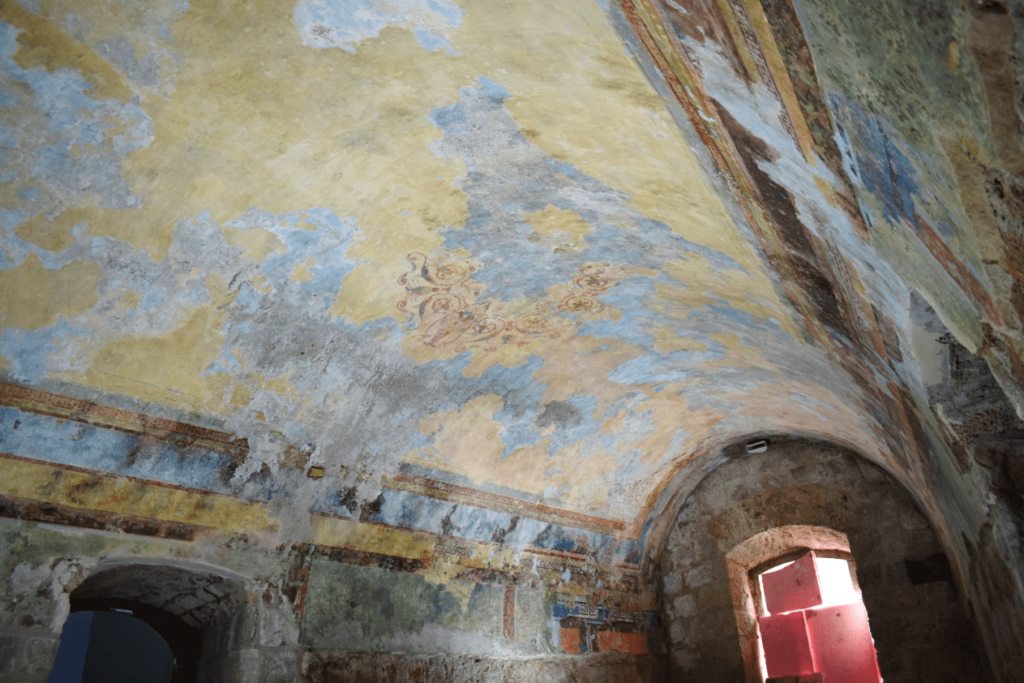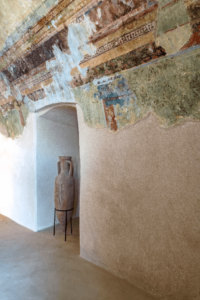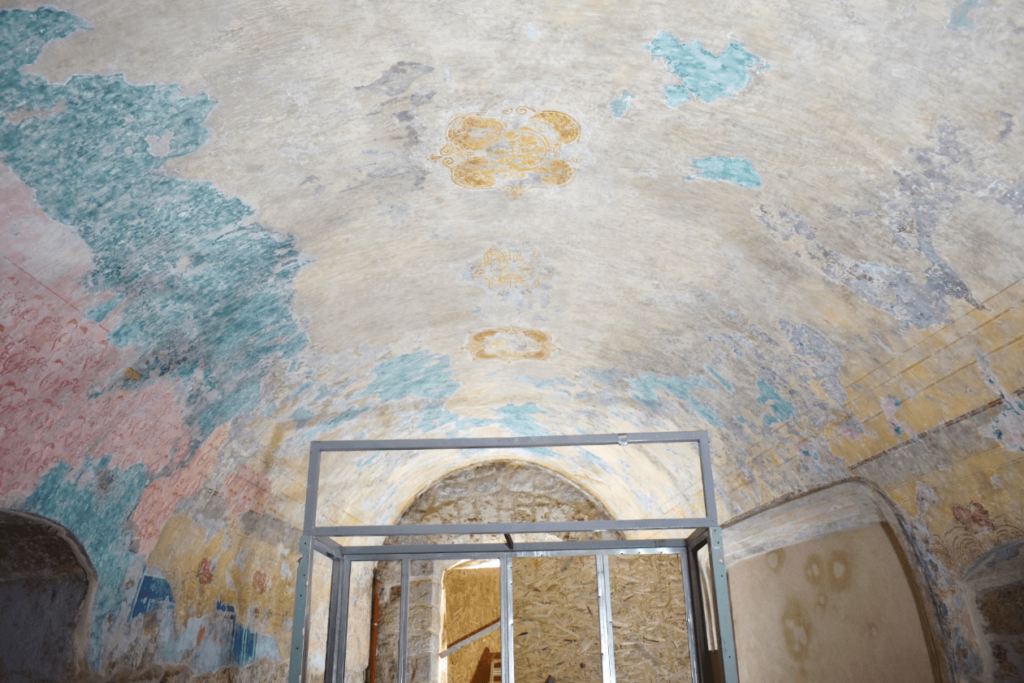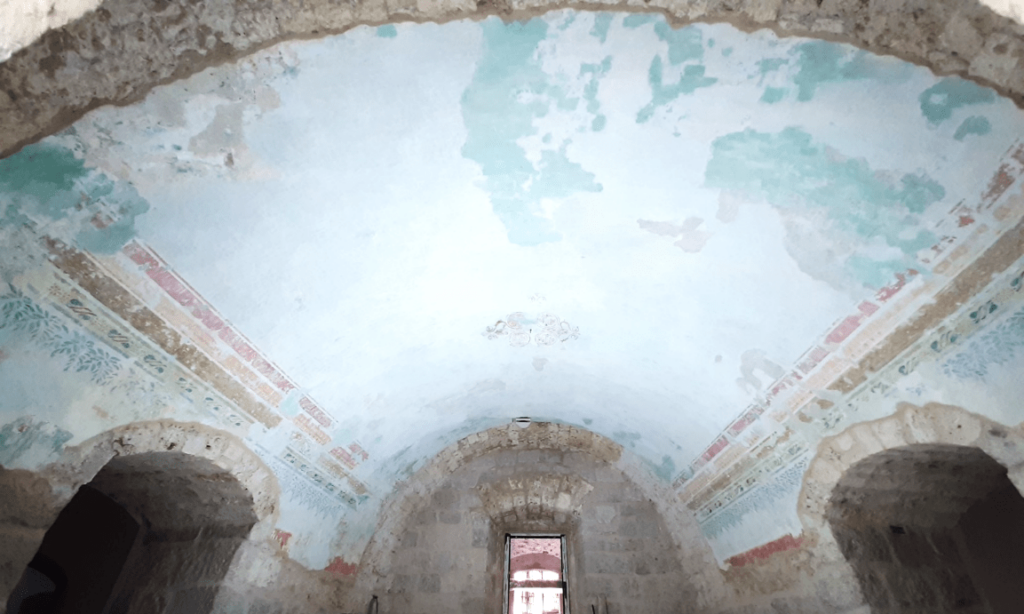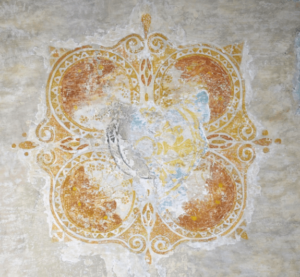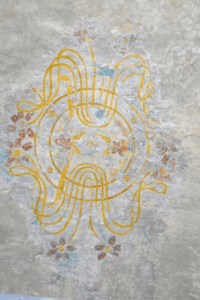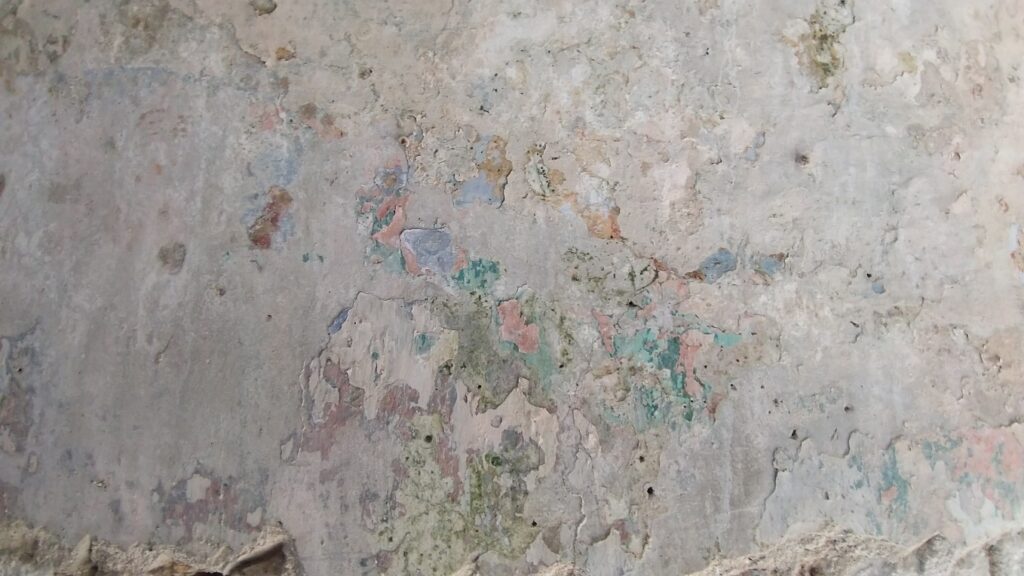At the beginning of 2021, during preparatory work on the floor of the circular tower, remnants of painted layers were observed beneath several layers of lime. Shortly after the discovery, the work was halted, and the Directorate for the Protection of Cultural Properties was notified. A report on the accidental find was submitted to the Directorate, and based on previously issued conservation guidelines, the process of conservation research began. Following the project's approval, the implementation of conservation measures was initiated.
On the upper floor of the circular tower, there are 12 trapezoidal rooms, a lift shaft, and a hallway with a spiral staircase. In nearly all the rooms (except for the lift shaft), remnants of coloured layers and decorative paintings were observed on the walls and vaults. These remnants were not found on the ground floor, only in the upper-floor rooms of the circular tower. At the beginning of the research, it was determined that prolonged exposure of the tower’s interior to atmospheric influences had caused the painted layers to be removed in earlier phases in some rooms, preserved in small percentages in others, and entirely lost in certain areas.
For this reason, a decision was made to continue conservation research in seven rooms. The research was conducted using non-invasive methods that preserved the integrity of the cultural property, by opening test probes in the upper layers of lime coating. Based on preliminary observations, it was concluded that the paintings aimed to give the upper-floor rooms of the tower a representative character, thereby distinguishing them from the rest of the structure. The significance of this research lies in the uniqueness of the findings, as no decorative wall paintings have been documented in other Austro-Hungarian fortifications.
To gain a more detailed understanding of the choice of painting materials and colours, and to confirm assumptions related to this decorative artwork, physical-chemical analyses of the painted layers, binders, and plaster were conducted prior to conservation-restoration works. Samples of the painted layers, along with layers of the original plaster, were collected on-site. These samples were analysed at the Laboratory for Stone and Aggregate of the Institute for Materials of Serbia (IMS).
Research and investigative work was carried out on the decorative wall paintings in seven painted rooms. During the probing examinations, several important conclusions were reached:
- All wall surfaces were covered with a layer of dirt bound to the painted layer by subsequent lime coatings, making it possible to discern the content and hint at the original colour palette only in certain cleaned areas.
- The paintings were executed using the secco technique
- Warm red and ochre are visibly the most dominant colours.
- The presence of straight-line borders with painted floral patterns was observed.
- A two-layer plaster, up to 3 cm thick, was identified.
- The decorative wall paintings are significantly damaged, preserved only in fragments, with visible cracks, deterioration, and an unstable bond to the substrate.
In this way, after more than a century, conditions have been created for the restoration of these wall paintings. Based on the preserved fragments, it can be concluded that the wall paintings served a decorative purpose and date back to the second half of the 19th century and the early 20th century. Pastel tones of moderate intensity were used, including warm ochre, red, brown, grey, light blue, light purple, and light green. These colours are typical and commonly found on buildings in Boka Bay with similarly decorated wall surfaces from the same period.
Lime formed the base for all the colours used. In addition to lime, the paints contained varying amounts of other elements used as additives, stabilisers, pigments, and similar components. Based on the remnants, it can be concluded that, in keeping with the period and the functional use of the upper-floor rooms of the tower, the artist skilfully designed and geometrically integrated compositions with ornamental details and symbolic motifs. Decorative ornamental reliefs were successfully imitated through painting. The research revealed borders featuring painted stylised floral decorations.
Based on physicochemical analyses, it was determined that the wall decorations in the rooms of the circular tower and the hallway with the spiral staircase were created using the secco technique on lime and lime-cement plaster. Deeper and shallower cracks were observed, and the absence of plaster as a base layer for the painted surface was noted in several places and across larger areas. Two layers of plaster were identified: the first, a coarser lime layer with a rougher texture (larger granulation), and the second, a much thinner and finer layer, often with added cement, on which the paintings were executed.
The majority of the painted surfaces were found to be in poor condition. It was determined that atmospheric moisture infiltration had caused degradation of the painted layer on the walls in all decorated rooms. The painted layer is flaking, its tonal quality has diminished, and in some areas, it has completely detached. The damage includes numerous cracks, dark stains, and subsequent coatings. In some places, the colours have changed due to the effects of moisture.
As the function of the rooms changed, numerous mechanical damages occurred during adaptations for new purposes. In addition to the described damages, subsequent lime coatings are visible over the original painted layers. These coatings vary in tone and degree of damage. The most recent layer is the easiest to remove, as it was most exposed to direct moisture influence. The base layer is solid but crumbles and disintegrates in places under light finger pressure. The final layer is a composite plaster made with a mixture of lime and cement binders. This plaster layer is firm and does not change under finger pressure.
The underlying substrate of the wall decorations was in poorer condition, as the effects of atmospheric moisture had significantly compromised the cohesion of the lime. Blisters were visible in several places, though larger blisters were rare. The painted layer suffered more severe damage than the substrate and the base. Delamination occurred most extensively in areas that had been repainted. The cause of the delamination was the excessive thickness of the subsequently applied paint layers and the stronger binder used.
Based on an assessment of the current condition, at least three and up to five subsequent lime coatings were identified over the original painted layer. These later coatings have darkened and become soiled. The effects of moisture are visually evident on the most recent white-painted layer, which displays reddish discolouration. The presence of moisture has also caused salt efflorescence in certain areas, further contributing to the degradation of the painted layer. Using percussion testing, the presence of detachments—specifically the separation of plaster from the wall substrate—was confirmed.
Following the completion of research work, conservation efforts and the restoration of wall and decorative painted surfaces were undertaken in 2022.


